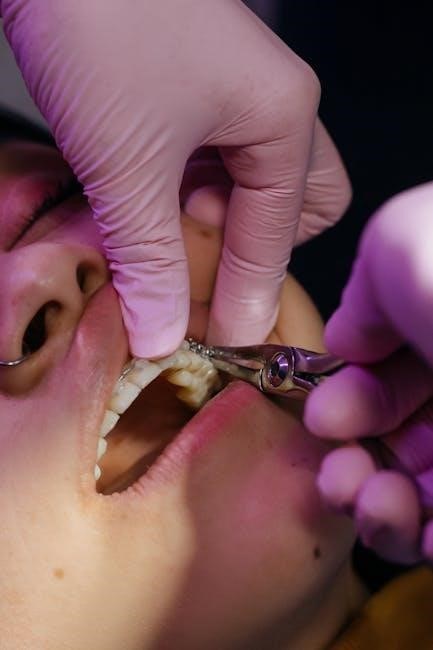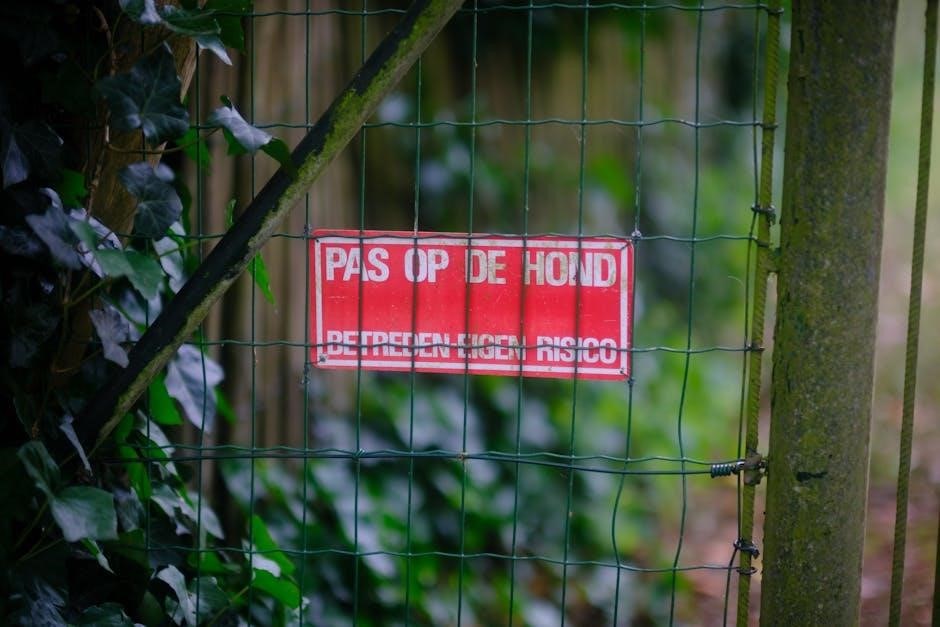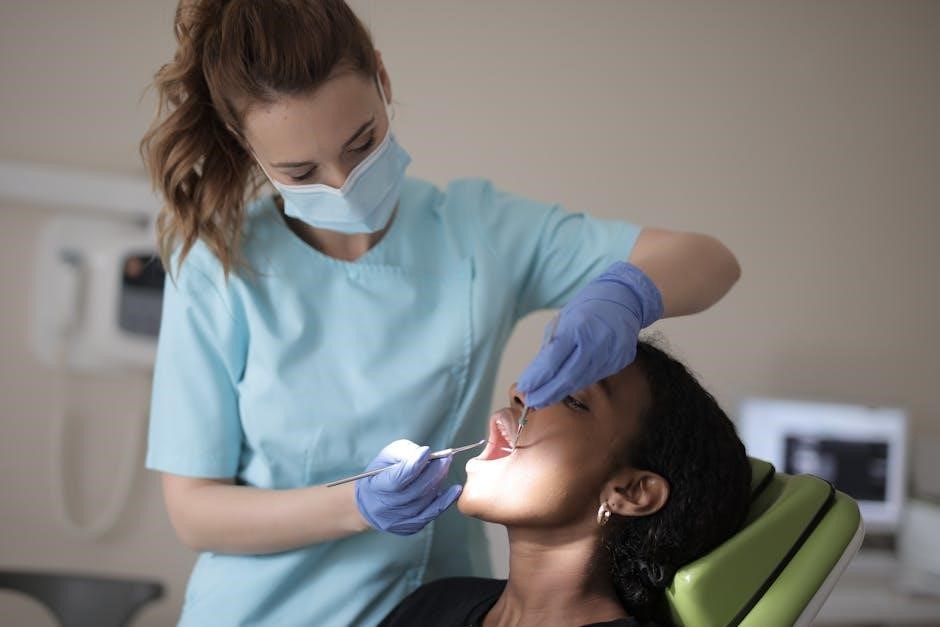post op instructions for tooth extraction
Proper post-operative care after tooth extraction is crucial for promoting healing, reducing complications, and ensuring a smooth recovery. Following specific guidelines helps protect the extraction site, prevent infection, and minimize discomfort. Adhering to these instructions ensures the formation of a blood clot, which is essential for healing. By understanding and following post-extraction care, patients can avoid complications like dry socket and promote timely recovery. This section provides a comprehensive guide to help patients navigate the healing process effectively.
Importance of Following Post-Operative Instructions
Following post-operative instructions after tooth extraction is essential for ensuring proper healing, minimizing discomfort, and preventing complications. These guidelines help protect the extraction site, promoting blood clot formation and reducing the risk of dry socket or infection. Adherence to instructions also helps manage pain effectively and supports overall recovery. By avoiding harmful activities and maintaining oral hygiene, patients can significantly improve their healing outcomes and avoid unnecessary setbacks. Proper care ensures a smoother and faster return to normal daily activities.
Overview of the Healing Process
The healing process after tooth extraction typically lasts several days to a week, with full recovery taking a few weeks. Initially, a blood clot forms to protect the socket, followed by granulation tissue growth. Swelling and discomfort are common but subside as healing progresses. Proper care, such as avoiding dislodging the clot and maintaining hygiene, supports tissue repair. Patients can resume normal activities gradually, with most returning to routine within a week. Monitoring for signs of proper healing ensures a successful recovery and prevents complications.

Immediate Care After Tooth Extraction
Immediate care involves protecting the extraction site, avoiding dislodging the blood clot, and maintaining cleanliness without disturbing the area to ensure proper healing and prevent complications.
Gauze Usage and Bleeding Control
After tooth extraction, gauze is placed over the site to control bleeding and promote clot formation. Patients should bite firmly on the gauze for 30-60 minutes. If bleeding persists, replace the gauze and apply pressure. Avoid spitting or rinsing vigorously, as this can dislodge the clot. The blood clot is essential for healing, so it’s crucial to protect it during the initial recovery period to prevent complications like dry socket and ensure proper wound healing.
Rest and Activity Level
Rest is essential after tooth extraction to promote healing and reduce bleeding. Patients should avoid strenuous activities for 24 hours and keep their head elevated to minimize swelling. Refrain from bending, lifting, or exercising, as these can dislodge the blood clot. Light activities can gradually resume, but overexertion should be avoided. Proper rest helps ensure the extraction site heals efficiently, reducing the risk of complications and supporting a smoother recovery process.
Initial Pain Management
After tooth extraction, managing pain is crucial for comfort. Apply a cold compress to the cheek near the extraction site to reduce swelling. Take prescribed painkillers as directed by your dentist. Avoid over-the-counter pain relievers without consultation. Rest and avoid chewing or biting near the extraction site. These steps help minimize discomfort and support healing. Proper pain management ensures a smoother recovery and reduces the risk of complications.
Diet and Nutrition After Tooth Extraction
A proper diet supports healing and reduces discomfort. Focus on soft, nutrient-rich foods like yogurt, eggs, and applesauce. Avoid hot, hard, or sharp foods that may irritate the site. Stay hydrated with water and avoid alcohol for 24 hours. A balanced diet aids recovery and ensures the extraction site heals smoothly and efficiently.
Recommended Foods for the First 24 Hours
After tooth extraction, opt for soft, cold foods to minimize discomfort and protect the extraction site. Ideal choices include ice cream, yogurt, pudding, applesauce, and cottage cheese. Avoid hot or hard foods that may dislodge the clot. Cold foods can also help reduce swelling. Stick to a bland diet for the first day to promote healing and prevent irritation. These foods are gentle on the mouth and provide essential nutrients for recovery.
Foods to Avoid During Recovery
Avoid hot, hard, spicy, or sharp foods for the first few days after tooth extraction to prevent dislodging the blood clot. Hot foods can dissolve the clot, while hard or sharp foods may damage the healing tissue. Spicy foods can irritate the extraction site, delaying recovery. Additionally, avoid using straws or drinking carbonated beverages, as suction can dislodge the clot. Stick to soft, bland foods and gradually reintroduce other foods only when healing is confirmed by your dentist, typically after 3-4 days.
Hydration Tips
Staying hydrated is crucial after tooth extraction to support healing and overall recovery. Drink plenty of fluids, such as water or clear broth, to keep your body hydrated. Avoid hot beverages for the first 24 hours, as they can dislodge the blood clot. Do not use straws, as the suction can disrupt the healing site. Stick to lukewarm or cool liquids initially and gradually introduce other fluids as comfort allows. Proper hydration helps maintain saliva flow, which aids in natural healing and prevents dry mouth.
Pain Management and Discomfort Relief
Managing pain effectively after tooth extraction is essential for a comfortable recovery. Follow your dentist’s advice, use prescribed or recommended medications as directed, and monitor pain levels closely.
Prescription Medications and Usage
Your dentist may prescribe pain relievers or antibiotics to manage discomfort and prevent infection. Always follow the dosage instructions provided. Start pain medication before numbness wears off to ensure effectiveness. Antibiotics should be taken as directed to combat infection. Never exceed the recommended dose or share medications. If you experience adverse effects, contact your dentist promptly. Adhering to the prescribed regimen ensures proper healing and minimizes post-operative complications.
Over-the-Counter Pain Relief Options
Over-the-counter pain relievers, such as ibuprofen (e.g., Advil, Motrin) or acetaminophen (e.g., Tylenol), can effectively manage mild to moderate pain after tooth extraction. Ibuprofen also reduces inflammation, which can aid in healing. Always follow the recommended dosage on the label or as advised by your dentist. These medications are suitable for most patients but should not replace prescribed painkillers if provided. If pain persists or worsens, consult your dentist for stronger options. Proper use of OTC medications ensures comfort during the recovery period.
Monitoring Pain Levels
Monitoring pain levels after tooth extraction is essential to ensure proper healing and comfort. Patients should track their pain intensity and note any changes. Mild to moderate pain is normal, but severe or increasing pain may indicate complications. Contact your dentist if pain worsens or persists beyond expected recovery timelines; Use prescribed or over-the-counter pain medications as directed to manage discomfort. Be aware of signs like swelling, redness, or fever, which may signal infection. Addressing pain promptly helps prevent issues and supports a smooth recovery process.
Oral Hygiene and Wound Care
Proper oral hygiene and wound care are vital after tooth extraction to promote healing and prevent infection. Avoid disturbing the blood clot, rinse gently with salt water, and keep the site clean to ensure proper recovery.
Rinsing Techniques and Salt Water Mouthwash
After 24 hours, gently rinse your mouth with warm salt water (1 teaspoon of salt in 8 ounces of water) to promote healing. Rinse 2-3 times daily, especially after meals, to remove debris. Avoid vigorous rinsing or using a straw, as this can dislodge the blood clot. Saltwater mouthwash helps reduce inflammation, kill bacteria, and soothe the extraction site. Continue this practice for several days or as directed by your dentist to support a clean and healthy recovery environment.
Avoiding Direct Brushing on the Extraction Site
Avoid brushing directly over the extraction site for the first few days to protect the blood clot and promote healing. Instead, gently brush other teeth with a soft-bristled toothbrush, being cautious around the area. Do not use harsh toothpaste or abrasive products. This precaution helps prevent dislodging the clot, which could lead to complications like dry socket. Continue this practice until your dentist advises it is safe to resume normal brushing habits, typically after the initial healing phase.
Antimicrobial Mouthwash Usage
Using an antimicrobial mouthwash after tooth extraction can help prevent infection and reduce inflammation. Start rinsing gently with a saltwater solution or prescribed mouthwash 24–48 hours post-procedure. Swish the solution around your mouth for 30 seconds, focusing on the extraction site, before spitting it out. Avoid vigorous rinsing to prevent dislodging the blood clot. Continue this practice 2–3 times daily for the first week to maintain oral hygiene and promote healing. Always follow your dentist’s specific instructions regarding frequency and type of mouthwash.

Activity Restrictions and Lifestyle Adjustments
- Avoid strenuous activities for 24–48 hours to prevent dislodging the blood clot.
- Refrain from smoking and consuming alcohol, as they hinder healing and increase infection risk.
- LIMIT physical exertion to promote recovery and avoid complications.
Smoking and Its Impact on Healing
Smoking significantly delays healing after tooth extraction by reducing blood flow to the extraction site. It increases the risk of dry socket and infection, as toxic chemicals in smoke impair the body’s natural repair processes. Smoking can dislodge the protective blood clot, leading to prolonged recovery and discomfort. Patients are strongly advised to avoid smoking for at least 24–48 hours after surgery to promote proper healing and minimize complications.
Alcohol Consumption Guidelines
Avoid consuming alcohol for at least 24 hours after tooth extraction, as it can interfere with healing and increase the risk of complications. Alcohol can irritate the extraction site, dislodge the blood clot, and prolong recovery. Additionally, alcohol should not be consumed while taking narcotic pain medications or antibiotics, as it may interact with these medications. Adhering to these guidelines is crucial for proper healing and to prevent potential issues like dry socket or infection.
Physical Activity and Exercise
Avoid strenuous physical activity for the first 24 hours after tooth extraction to promote healing and prevent dislodging the blood clot. Rest is crucial during this period to minimize bleeding and swelling. After the first day, you can gradually resume light exercise, but avoid heavy lifting, bending, or vigorous workouts for a few days. Excessive activity may disrupt the healing process or lead to complications. Listen to your body and cease activity if discomfort or bleeding increases.

Follow-Up Care and Appointments
Attend all scheduled follow-up visits to monitor healing progress and address concerns. These appointments ensure proper recovery and allow your dentist to check the extraction site and remove sutures if necessary.
When to Schedule a Follow-Up Visit
Typically, follow-up visits are scheduled within 7-10 days after extraction to monitor healing and remove sutures if placed. However, if symptoms like persistent pain, swelling, or bleeding worsen, contact your dentist immediately. Early signs of complications, such as dry socket or infection, require prompt attention. Adhering to recommended timelines ensures proper evaluation and prevents potential issues from escalating, promoting a faster and more effective recovery process overall.
Signs of Proper Healing
Proper healing after tooth extraction is indicated by the formation of a dark clot at the extraction site, gradual reduction in swelling, and diminishing pain or discomfort. Bleeding should stop within 24 hours, and the gums should begin to close naturally. By the 7-10 day mark, the site should appear pink and granular, signaling new tissue growth. If these signs are present and no complications arise, healing is progressing as expected. Monitoring these indicators helps ensure a successful recovery without unnecessary interventions.
Removing Stitches or Sutures
Stitches or sutures are typically removed 7-10 days after tooth extraction, depending on the complexity of the procedure and the material used. Absorbable sutures dissolve on their own, while non-absorbable ones require a follow-up visit for removal. Suture removal is usually quick and painless, as the area may still be numb. Your dentist will schedule an appointment to check the healing progress and remove any necessary sutures. It’s important to attend this visit to ensure proper healing and avoid complications.

Potential Complications and Emergency Care
Complications like dry socket, infection, or excessive bleeding can arise if post-op instructions are not followed. Seek immediate medical attention if symptoms worsen or persist unexpectedly.
Dry Socket (Alveolar Osteitis) Prevention and Treatment
Dry socket, or alveolar osteitis, is a common complication where the blood clot dislodges, exposing bone and nerve endings. Prevention includes avoiding smoking, vigorous rinsing, and using straws. Treatment involves flushing the socket with saline and applying medicated dressings. Patients should contact their dentist immediately if they experience severe pain, bad breath, or an empty socket. Early intervention can alleviate discomfort and promote healing, preventing further complications.
Signs of Infection
Signs of infection after tooth extraction include increased swelling, redness, pus, or fever. Patients may experience severe pain, a foul taste, or bad breath. If these symptoms persist or worsen, it indicates potential infection. Contact your dentist immediately for evaluation and treatment, which may involve antibiotics or further intervention. Early detection is crucial to prevent complications and ensure proper healing.
When to Seek Immediate Medical Attention
Seek immediate medical attention if you experience heavy bleeding, severe pain, swelling, or difficulty breathing. Fever, chills, or excessive pus at the extraction site also require urgent care. If you suspect infection, dry socket, or experience unbearable discomfort, contact your dentist right away. Prompt intervention ensures complications are addressed early, preventing serious health issues and supporting a successful recovery. Delaying care can worsen symptoms, so act quickly if unusual or severe symptoms arise.
Tips for a Smooth Recovery
Use cold compresses to reduce swelling, keep the extraction site clean, and manage swelling and bruising with gentle care. These steps ensure a comfortable and speedy recovery.
Using Cold Compresses for Swelling
Applying a cold compress or ice pack to the cheek near the extraction site can reduce swelling and discomfort. Use it for 15-20 minutes at a time, with breaks in between. This helps minimize swelling and promotes a smoother recovery. Repeat as needed, especially during the first 24 hours, to ensure optimal comfort and healing.
Keeping the Extraction Site Clean
Proper oral hygiene is essential to prevent infection and promote healing. After 24 hours, rinse gently with warm salt water several times a day to keep the area clean. Avoid vigorous rinsing or using straws, as this can dislodge the blood clot. Use an antimicrobial mouthwash if recommended by your dentist to reduce bacteria. Gently clean the area without disturbing the extraction site, ensuring it remains free from debris. This helps prevent complications like dry socket and supports a healthy recovery process.
Managing Swelling and Bruising
To reduce swelling and bruising after tooth extraction, apply a cold compress to the affected area for 15-20 minutes at a time during the first 24 hours. Elevate your head slightly while resting to minimize swelling. Mild bruising and swelling are normal and typically subside within a few days. Avoid strenuous activities that may worsen swelling. Using ice packs and following these steps can help alleviate discomfort and promote a smoother recovery process.
Following post-operative instructions ensures a smooth recovery, promotes healing, and prevents complications. Adhering to guidelines helps protect the extraction site and supports overall oral health effectively.
Adhering to post-operative instructions is essential for proper healing and preventing complications. Key strategies include protecting the blood clot, managing pain, eating soft foods, avoiding harmful habits like smoking, and maintaining oral hygiene. Gently rinsing with salt water, avoiding direct brushing on the site, and following dietary guidelines are crucial. It’s important to rest, avoid strenuous activities, and refrain from alcohol for 24 hours. Monitoring for signs of infection or dry socket and attending follow-up appointments ensures a successful recovery and minimizes risks;
Final Tips for a Successful Recovery
Staying hydrated, using cold compresses for swelling, and keeping the extraction site clean are vital. Avoid smoking, alcohol, and strenuous activities to prevent complications. Stick to soft foods initially and gradually introduce normal diets. Monitor healing progress and attend follow-up appointments. By following these tips, patients can ensure a smooth and uneventful recovery, minimizing risks and promoting optimal healing outcomes after tooth extraction.
